US Dollar Exchange Rates of 25th
May 2017
China Yuan 6.8555
Report from China
Real estate development in the first four months of
2017
In a press release the National Bureau of Statistics in
China reported national real estate sales for the first four
months of 210 increased by just over 9% year on year.
Investment in residential buildings was up by10.6% down
slightly from a month earlier. However, April sales rose at
the slowest rate for several months after more
municipalities introduced regulations to slow demand for
residential properties.
The crackdown on speculative housing investment was
strongest in the provinces close to Beijing because a new
city plan has sparked excitement of investors looking for
quick buy and sell profits.
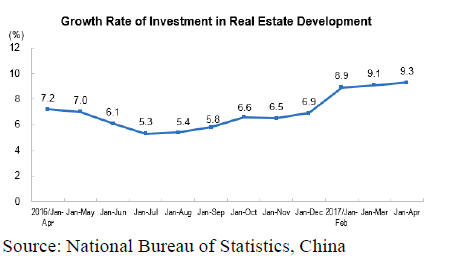
Despite the attempts to reigning the housing market, in the
first four months there was an increase in the area of land
purchased by real estate developers.
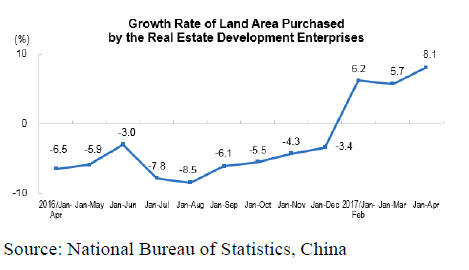
See:
http://www.stats.gov.cn/english/PressRelease/201705/t20170517
_1495113.html
No more fees for entry-exit inspection and quarantine
As of 1 April China¡¯s Ministry of Finance and National
Development and Reform Committee removed the need
for traders to pay the inspection and quarantine entry and
exit fees for all import and export commodities. The aim
of this measure is to mitigate burden on enterprises.
While the fees have been eliminated enterprises must
follow the previous formalities.
Call for abolition of consumption tax on wooden
flooring
Recently, a large group of companies called for the
abolition of the consumption tax on solid composite
flooring as the industry is facing tough market conditions.
A 5% of consumption tax has been paid on solid
composite flooring for 10 years but this has eaten into the
profitability of many wood flooring producers, some of
which are said to be on the verge of bankruptcy. The tax
burden has undermined demand and this, along with rising
labour and raw material costs have created a serious
situation for manufacturers.
Output from redwood enterprises falls
It is estimated that there were 15,000 Chinese redwood
enterprises in 2016 with annual output value of RMB90
billion. However in 2016 the value of output fell 10%
from the previous year.
The Chinese redwood industry is mainly centered on
Beijing, Shanghai, Hebei, Shandong, Jiangsu, Zhejiang,
Fujian, Yunnan, Guangdong, Guangxi and Jiangxi
provinces.
Surge in timber imports through Zhangjiagang port
According to the Zhangjiagang Entry-Exit Inspection and
Quarantine Bureau in Jiangsu province, in the first quarter
of 2017, containerised timber (logs and sawnwood)
imports through Zhangjiagang port surged over 60% year
on year to 130,000 cubic metres accounting for 37% of the
total imports volume through the port in 2016.
The imported timbers were mainly from Gabon,
Cameroon, Mozambique and Zambia Zambia (mainly
Pterocarpus tinctorlus, a rosewood look-a-like).
Rubber production in Hainan province
Hainan Natural Rubber Industry Group has a national
largest natural rubber production base with 250,000
hectares of rubber plantations.The annual output of latex is
230,000 tonnes.
The Group has 12 rubberwood processing factories
producing around 300,000 cubic metres of sawn
rubberwood, 30,000 cubic metres of laminated timber,
8,000 door sets and about 5,000 cabinet furniture items.
Rise in wood furniture exports from Huizhou City
According to Entry-Exit Inspection and Quarantine
Bureau, furniture exports from Huizhou City in
Guangdong province rose 17% to US$133 million in 2016.
Wooden furniture exports from Huizhou City have
increased every year for the past 7 years.
There are about 180 wooden furniture enterprises in
Huizhou City. The main products are wooden tables and
chairs, wood frames for sofas, wooden kitchenware and
wooden crafts. The main markets are the USA, European
Union, Japan, Australia, UAE and Malaysia.
As trade expands under China¡¯s ¡®Belt and Road¡¯ strategy,
Huizhou wooden furniture makers have diversified exports
reaching out to, for example, Cameroon, Mongolia,
Kuwait and Qatar. Furniture exports to Southeast Asia, the
Middle East and Africa continued to increase.
According to the available statistics, the export value of
wooden furniture manufactured in Huizhou City in 2016
almost doubled to US$580 million between 2010 to 2016.
First imported timber port in West China
A signing ceremony was recently held to launch the
RMB30 bllion western timber trade centre in Banan
District, Chongqing City. Chongqing is situated between
the Qinghai-Tibet Plateau and the plain at the middle and
lower reaches of the Yangtze River.
It has been reported that wood consumption by
manufacturers in Chongqing City has grown steadily for
several years. Timber consumption by wood processing
enterprises in the western provinces account for around
40% of total consumption. It is anticipated that timber
consumption in the western provinces could reach 20
million cubic metres by 2020.
The establishment of a new timber import port and
distribution centre for imported wood products will attract
wood processing enterprises from the coastal regions. It is
expected that timber industry clusters will be created in the
future.
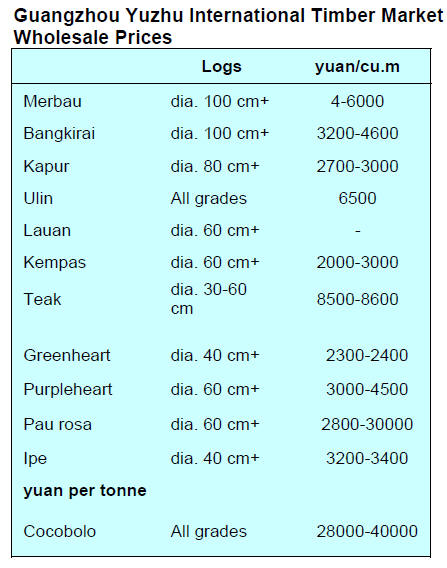
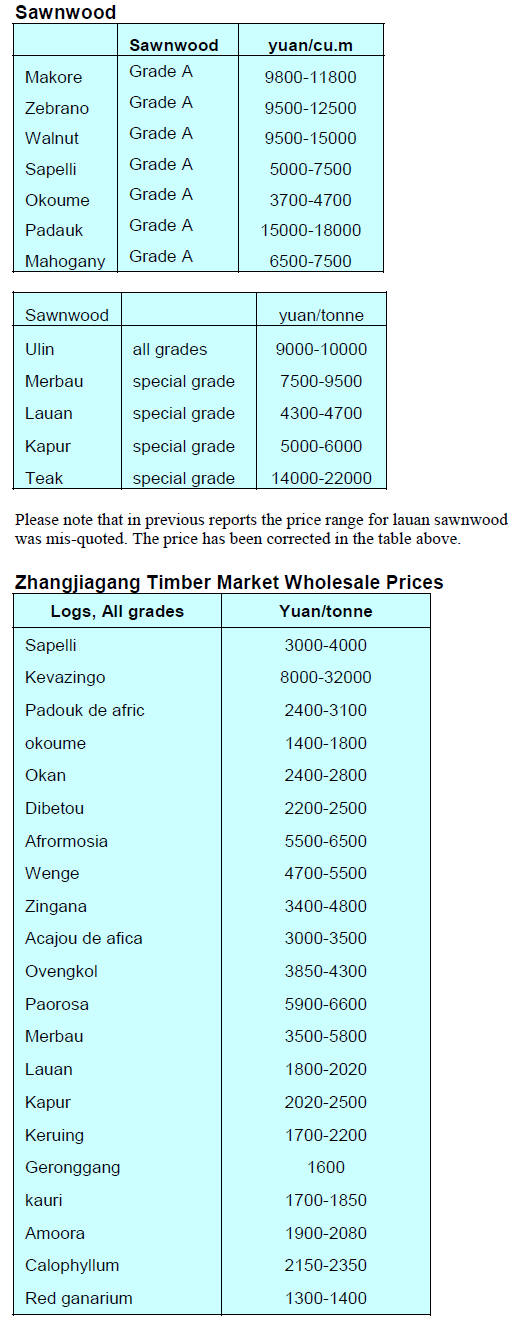 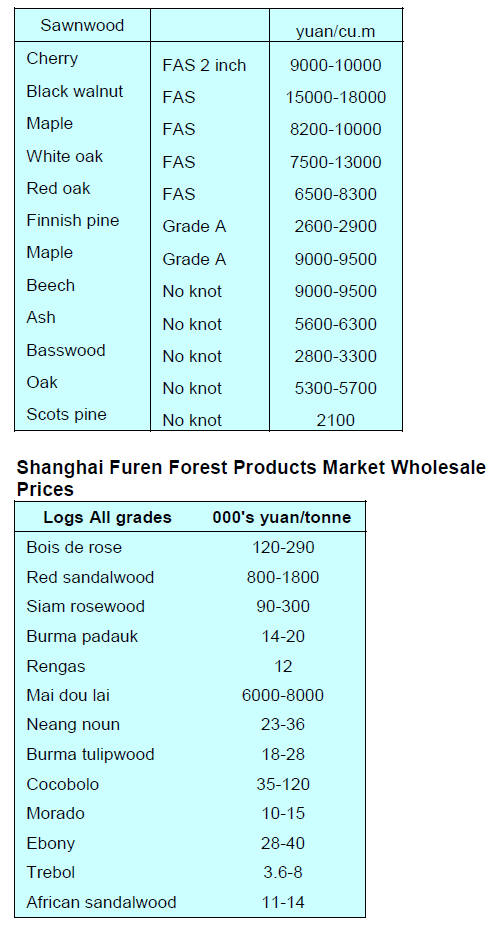
Shanghai manufacturers began to relocate
Traders report that activity in the Shanghai timber markets
is very quiet. Analysts say one reason is that many wood
processing plants have relocated.
As early as March this year wood processing enterprises in
Shanghai without environment impact assessment
certificates were asked to stop production. Also many
wood processing factories began to move to Zhangjiagang
and Taicang Ports due to the increase in rent and labour
costs in Shanghai.
It is estimated that about 1,000 furniture makers have
moved out. As this trend continues the timber markets at
Taicang and Zhangjiagang will play a greater role in
distribution.
|